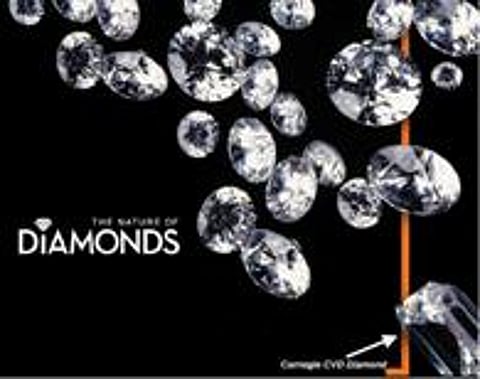

India's Ministry of Commerce has decided to separate the Harmonized System Codes (HS Codes) for Chemical Vapour Deposition (CVD) and natural diamonds, respectively, in response to recent incidents of undisclosed lab-grown diamonds being mixed with parcels of natural diamonds. GJEPC is striving hard to separate the Harmonized System Codes (HS-codes) for CVD diamonds and natural diamonds, which were hitherto placed under the same HS code, that enabled some deceitful diamond dealers to export CVD diamonds as natural diamonds either mixed or unmixed with genuine natural diamonds.Diamond industry insiders are of the view that CVD diamonds are sold with mixing in the domestic market too, and feel the necessity of legislation to curtail this trend too.
Lab-grown diamonds first entered the consumer markets in the 1990s, but were easily detected by experienced dealers. However, due to the modern technology, the difference between natural and CVD diamonds is now difficult to detect with the naked eye, and instances of consumers being cheated by dishonest dealers have been reported. A consumer can know the difference only by taking the diamonds to a laboratory.Currently, the trade for natural and laboratory-grown diamonds is done through the same HS Code. The Directorate General of Foreign Trade (DGFT) is responsible for assigning HS Codes to different objects. The sale of laboratory-grown diamonds is quite rampant in the domestic market. Meanwhile, the import of synthetic rough diamonds has increased phenomenally in 2013 at $83 million. All the synthetic rough diamonds imported into the country are brought to Surat for further processing. Once the diamonds are polished, they are mixed with the natural diamond parcels and exported under the same HS code.
This was to be finalised during a meeting between representatives of India's Gems & Jewellery Export Promotion Council (GJECP) and the Directorate General of Foreign Trade (DGFT), which is responsible for assigning the HS Codes to different objects. The meeting was scheduled in mid Janauary. But there is heard no outcome of the said meeting as yet.Pankaj Parekh, Vice Chairman of GJEPC says, “Due to the same HS Codes being used for natural and CVD diamonds, there have been cases of CVD diamonds being exported overseas in the name of naturals. This is raising a big question on India’s trust value. If the HS Codes are different then such incidences can be barred easily. We are just asking to add one more digit ahead of the existing code, for example even China has extended their codes to 10 digits.The delay in separating the HS codes is affecting our reputation worldwide. It is very dangerous for the country and the industry. Why the government and the DGFT are not taking measures to separate HS codes at the earliest? This is surprising.”
The primary advantage of different HS codes is that the industry will be able to track the quantum of lab grown diamonds entering the country. It will enable transparency for those companies who want to deal in the product in a transparent manner. It will also give more legal teeth for the authorities to go after any company indulging in wilful non-disclosure during imports and exports, uttersColin Shah, MD, Kama Schachter. Hitesh Patel, Director, Dharmanandan Diamonds opines, “Certainly it will be helpful to differentiate both category diamonds. Currently in case of same HS codes for both types of diamonds, the importer is not liable to define the type of diamond under the code, it may cause the mishaps. Once there is separate HS Codes, it will be easy to identify the importers who imports CVD type diamonds.” He further adds, “Well, if it would come earlier, that is always better, but again, this is also correct time. While synthetic or CVD is the foremost threat to world diamond industry, it is the best time to avoid or slower the situation against the exquisiteness of natural diamond.” Pankaj Parekh further echoes, “While it would naturally have been better if the step had been taken earlier, there should not be a big impact of the delay, as the current quantum of lab grown diamonds in the market is still small.”He also adds, “At present the production and mixing of CVD diamonds is minimal, and hence should be curbed at the initial stages itself.”
As a grading and certifying institute, Tehmasp Printer, Managing Director,International Gemological Institute, India says, “Deterrence, disclosure and detection is what the need is. And we have the sufficient machinery and technology to detect the un-natural diamonds. But separate HS Codes were due since long and this step will surely help.”Due to the same HS Codes being used for natural and CVD diamonds till now, the circulation and mixing was easy. Separate HS codes and complete disclosure will bring an end to such problems. It’s always earlier the better, says Ghanshyam Dholakiya, Director, Hari Krishna Exports Pvt Ltd. But, now what is important is the quick implementation of these codes which is beneficial for the entire Industry, he further states.
Uday Chinai,Chairman and Managing Director, BVC Logistics expresses that apart from HS Codes, to regain the trust, most important is declaration and identification. There should be strong business ethics to stop this unethical mixing. Hitesh Patel holds similar view, “Irrelative of the future situation, everybody should try to stop undisclosed synthetic diamonds entering the market. If it goes worst then it will not only affect India, but the entire diamond and jewellery industry.” Ghanshyam Dholakiya rightly puts, “India is still the most ‘Trustworthy’ nation as far as diamonds are concerned and this ‘trust factor’ is the basis/origin of the entire trade. The need of the hour is to take immediate corrective actions to protect the reputation as well as to curb such incidents. Any rule which is beneficial for the entire diamond industry and helps in preventing such incidences is most welcome.”
Follow DiamondWorld on Instagram: @diamondworldnet
Follow DiamondWorld on Twitter: @diamondworldnet
Follow DiamondWorld on Facebook: @diamondworldnet
